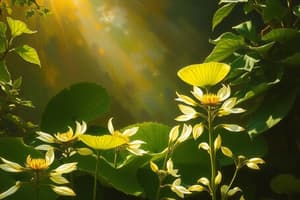Podcast
Questions and Answers
What are autotrophs?
What are autotrophs?
- Organisms that can only live in water
- Organisms that cannot make their own food
- Organisms that get energy from other organisms
- Organisms that can make their own food from the sun (correct)
What do heterotrophs do?
What do heterotrophs do?
- They can make their own food from the sun
- They cannot make their own food from the sun (correct)
- They get energy through photosynthesis
- They only eat plants
Plants and some other types of organisms are able to use __________ to produce food.
Plants and some other types of organisms are able to use __________ to produce food.
light energy from the sun
What is ATP?
What is ATP?
The characteristics of ATP make it exceptionally useful as _________________
The characteristics of ATP make it exceptionally useful as _________________
What is photosynthesis?
What is photosynthesis?
Who discovered that plants release oxygen?
Who discovered that plants release oxygen?
Photosynthesis uses _______________ to convert _______________ and _____________ into high energy sugars and oxygen.
Photosynthesis uses _______________ to convert _______________ and _____________ into high energy sugars and oxygen.
In addition to water and carbon dioxide, photosynthesis requires _________ and ______________, a molecule in chloroplasts.
In addition to water and carbon dioxide, photosynthesis requires _________ and ______________, a molecule in chloroplasts.
What are pigments?
What are pigments?
What is the principal pigment in plants that absorbs light?
What is the principal pigment in plants that absorbs light?
What are thylakoids?
What are thylakoids?
What are photosystems?
What are photosystems?
What is the stroma?
What is the stroma?
What is NADP+?
What is NADP+?
What do light-dependent reactions produce?
What do light-dependent reactions produce?
A membrane protein called _________________________ allows H+ ions to pass through the thylakoid membrane.
A membrane protein called _________________________ allows H+ ions to pass through the thylakoid membrane.
What is the Calvin cycle?
What is the Calvin cycle?
Where does photosynthesis take place?
Where does photosynthesis take place?
Light-independent reactions (The Calvin process) take place ___________
Light-independent reactions (The Calvin process) take place ___________
Light-dependent reactions take place ___________
Light-dependent reactions take place ___________
What does ATP power?
What does ATP power?
What does chlorophyll a absorb?
What does chlorophyll a absorb?
What does chlorophyll b absorb?
What does chlorophyll b absorb?
Why do plants look green?
Why do plants look green?
What is electron transport?
What is electron transport?
What is the electron transport chain?
What is the electron transport chain?
What is ATP made up of?
What is ATP made up of?
What is ADP?
What is ADP?
What do light-dependent reactions produce?
What do light-dependent reactions produce?
What can H+ ions not do?
What can H+ ions not do?
What starts the photosynthesis process?
What starts the photosynthesis process?
What reenergizes high-energy electrons?
What reenergizes high-energy electrons?
What does the Calvin cycle use?
What does the Calvin cycle use?
What can slow or stop photosynthesis?
What can slow or stop photosynthesis?
Flashcards are hidden until you start studying
Study Notes
Photosynthesis Overview
- Autotrophs produce their own food using sunlight, while heterotrophs depend on other organisms for energy.
- Light energy from the sun is essential for photosynthesis, which converts this energy into chemical energy.
Key Components of Photosynthesis
- ATP (adenosine triphosphate) is the primary energy carrier in cells, critical for various biological functions.
- Photosynthesis involves converting light energy into ATP and NADPH through light-dependent reactions, which produce oxygen gas as a byproduct.
- The overall equation for photosynthesis: 6CO₂ + 6H₂O + light → C₆H₁₂O₆ + 6O₂.
Structures Involved in Photosynthesis
- Chlorophyll is the principal pigment that absorbs light, working effectively in blue-violet and red regions of the spectrum.
- Thylakoids, sac-like membranes within chloroplasts, house the photosystems, which are essential for capturing light energy.
- The stroma is the fluid-filled area surrounding thylakoids where the Calvin cycle occurs, utilizing energy from light reactions to produce glucose.
The Light-Dependent Reactions
- Light-dependent reactions occur within the thylakoid membrane and rely on sunlight to energize electron transport chains, producing ATP and NADPH.
- ATP synthase, a membrane protein, facilitates the passage of H+ ions, ultimately generating ATP.
- The reactions also produce oxygen gas, which is released into the atmosphere.
The Calvin Cycle
- The Calvin cycle uses energy from ATP and NADPH generated in light-dependent reactions to convert carbon dioxide into high-energy sugars.
- This cycle occurs in the stroma and involves the fixation of CO₂ to produce glucose.
Pigment and Light Interaction
- Chlorophyll absorbs light efficiently, but does not absorb green light well, causing plants to appear green as this light is reflected.
- Pigments play a crucial role in absorbing various wavelengths of light necessary for photosynthesis.
Influencing Factors
- The rate of photosynthesis can be affected by water availability, temperature, and light intensity.
- Light-harvesting complexes collect light energy and pass it to reaction centers in photosystems for further processes.
Additional Insights
- NADP+ functions as an electron carrier, transferring high-energy electrons from chlorophyll to other molecules.
- Understanding the role of photosystems I and II helps in grasping how light energy is transformed into chemical energy. Photosystem II initiates the process while Photosystem I re-energizes the electrons.
Summary of Energy Forms
- ATP is often compared to a fully charged battery, while ADP represents a partially charged state.
- ATP provides energy for cellular functions, including active transport, protein synthesis, and muscle contraction.
Studying That Suits You
Use AI to generate personalized quizzes and flashcards to suit your learning preferences.




